Literature on the technical side of the Linotype & Intertype (and the Teletypesetter). Also third party, related and ancillary equipment.
This includes material that I have scanned and reprinted, links to material reprinted by others, and some bibliographic references for material not yet reprinted.
This section also includes some engineering drawings by former manufacturers (Star Parts, Mergenthaler) and a few contemporary individuals making reproduction/replacement parts. In theory these should probably be in their own section, but they're so heavily cross-linked with parts books that it seemed better to put them here.
(See the note in the overall Composing Linecasters Notebooks for an explanation of why many of the links here don't currently work.)
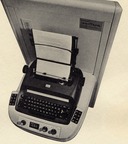
Ludlow Typograph Company
This includes only the Ludlow Swiftape (intended for use with composing linecasters). For the Ludlow Typograph, see Ludlow Typograph set of Notebooks. For the Elrod, see the Elrod Notebooks.
Note: See Metal Feeders in Common Casting Equipment for Monomelt, Margach, etc. metal feeders.

Individuals
Several individuals have begun reverse-engineering Linotype/Intertype compatible parts. What is particularly exciting is that some of them have released their engineering drawings for use by others. From these beginnings, it is to be hoped that someday we will be able to build new Linotypes and Intertypes as open-source hardware.
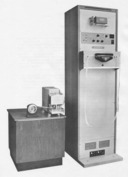
Compugraphic
The Justape line of standalone typographic computers. These processed TTS-style punched paper tape for both hot metal linecasters and for tape-driven phototypesetters.
(The unit on the left in the image here is a standard Teletype High Speed Tape Punch Set (BRPE Type).)
For an independent, but conceptually related machine see the Ludlow Swiftape in the Ludlow section (above).
The bulk of Compugraphic typographic equipment, however, was involved with phototypesetting.
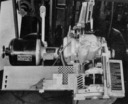
Curle Mfg. Co. / Curlesaw Co.
Curle Manufacturing Company, and possibly later Curlesaw Company. The Curle Slug Corrector.
For the Curle Matrix Anvil (which was manufactured by the Monomelt Company), see Monomelt Co. Linecasting Accessories; Curle, below.
For an overall list of devices by George L. Curle covered on CircuitousRoot, including the Monomelt System, see ../../ Common Casting Equipment -> Metal Feeders -> The Monomelt System.

Digitronic
[NOTHING YET] A Digitronic Corp. (Albeston, NY) "Dial-o-verter" was used as a modem in the transatlantic Teletypesetter hookup of the Guardian (UK) and the NY Times on 1960-10-08. See James, L. W. "Guardian - New York Times Link Up in Atlantic TTS Experiment" in Intertype Interludes (Autumn 1962): pp. 12-13. It was "just" a modem, but it was reading 6-level TTS tape.
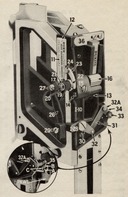
Duex Engineering Products
Spaceband cleaning tool built into the spaceband box.
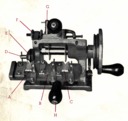
Esham's Matrix Milling Machine
Convert a matrix from running pi to running in a channel.

Hamilton (Linecaster Products)
For the most part, Hamilton is known for its wood type and for composing room items. Some of their products were linecaster-specific, however, such as their Operator's Cabinets and Matrix Cabinets.
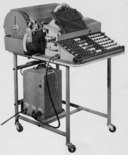
International Typographical Union
The Brewer Keyboard for the Teletypesetter (developed by Unitypo, Inc.), an ETAOIN keyboard for the QWERTY TTS.
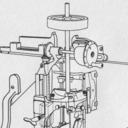
Mohr
Mohr Saw Installing Instructions (Linotype) Edition C. [Mohr Autopositor.] [MORE TO DO]

Monomelt Co. Linecasting Accessories; Curle
The Curle Matrix Anvil, manufactured by the Monomelt Company (better known for its Monomelt System of hot metal feeders).
For the Curle Slug Corrector, see the Curle Mfg. Co. / Curlesaw Co. Notebooks, above.
For a list of all Monomelt Company products covered on CircuitousRoot, including the Monomelt System of hot metal feeders, see Common Casting Equipment -> Metal Feeders -> The Monomelt System

Reid Brothers
[NOT DONE] Spacebands. Since 1906. See Inland Printer ads, 1920s.

Robotype
[NOT DONE] A French system which began as an ETAOIN linecaster tape perforator and evolved into a general typographic computing system.

Simoncini
[NOTHING ONLINE] Simoncini was best known for their matrices, but also made or sold several items of equipment. These included the TP 5 Unjustified Tape Perforator Keyboard (for 5 to 8 level tape).
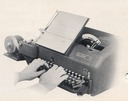
Teletypesetter Corp. and Fairchild TTS Literature
Teletypesetter Corporation (from 1932), then Fairchild Graphic Equipment (from 1958). Link to Comet-specific maintenance documents.

Devices of Unknown Manufacture
A matrix cleaning galley patented by George L. Curle.

Technical
[Thompson. Mechanism of the Linotype.] McCall. Linotype Manual. Harding & Loomis. Linecasting Operator-Machinist. [Intertype Mouthpiece and Throat Cleaning Film]
The literature collected (or pointed to from) here is primarily technical in nature, and exclusively oriented toward linecasters. For more general treatments of composing and casting machines (especially historical surveys such as Thompson's History of Composing Machines and general technical treatises such as Legros and Grant) see the section on Literature for Machine Composition and Casting in the Tools set of Notebooks.
See the Bibliography for references to other material, especially that reproduced by:
It is also worth checking Google Books and The Internet Archive.
Note that the reproductions here are incomplete because I'm scanning this material as I have need for it in the restoration of my own machines.
The Teletype and Teletypesetter break my categories. Teletypesetter equipment (using 6-Level tape) was based in large part on Teletype equipment (using 5-level tape), so one argument would put them all over in the Telegraphy section. Yet both were used in newspaper service, so they should both be here in the Typefoundry and Press. Moreover, the success of the Teletypesetter resulted not only in competitive and third-party equipment, but in related linecaster features (such as mat detectors) and operating procedures which would not have existed without the TTS. At the same time, TTS and TTS compatible equipment also drove many phototypesetting machines (suggesting that it should be in the Phototypesetting section) and resulted in some of the first commercial typographic computing equipment (arguing that it should be in an as-yet nonexistent digital typography Notebook)
Instead of gathering all Teletype and Teletypesetter related items in one place, I'm going to distribute them in several:
Teletypesetter-related literature was produced by several companies, and sometimes it was only a small part of their linecaster offering. It isn't always obvious, a priori, where to look (e.g., Mergenthaler literature for Linotype adjustments when operating at Teletypesetter speeds, or equipment modification services by the Mohr Lino-Saw Company). This is a quick top-level index into the various places where Teletypesetter literature lurks in these Notebooks.
All portions of this document not noted otherwise are Copyright © 2008-2013 by David M. MacMillan and Rollande Krandall.
Circuitous Root is a Registered Trademark of David M. MacMillan and Rollande Krandall.
This work is licensed under the Creative Commons "Attribution - ShareAlike" license. See http://creativecommons.org/licenses/by-sa/3.0/ for its terms.
Presented originally by Circuitous Root®
Select Resolution: 0 [other resolutions temporarily disabled due to lack of disk space]